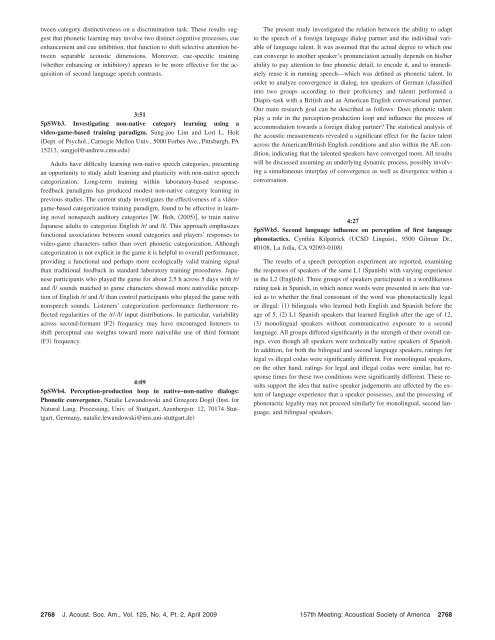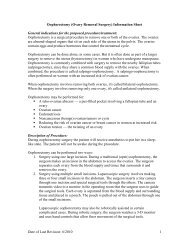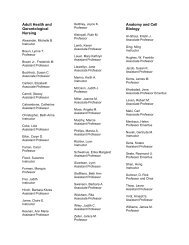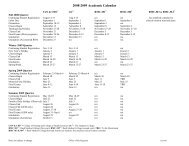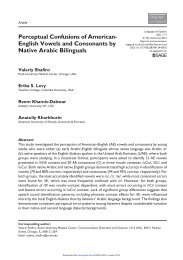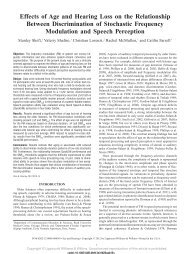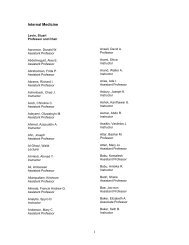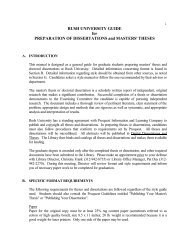Perceptual confusions of American English vowels ... - Rush University
Perceptual confusions of American English vowels ... - Rush University
Perceptual confusions of American English vowels ... - Rush University
Create successful ePaper yourself
Turn your PDF publications into a flip-book with our unique Google optimized e-Paper software.
tween category distinctiveness on a discrimination task. These results suggest<br />
that phonetic learning may involve two distinct cognitive processes, cue<br />
enhancement and cue inhibition, that function to shift selective attention between<br />
separable acoustic dimensions. Moreover, cue-specific training<br />
whether enhancing or inhibitory appears to be more effective for the acquisition<br />
<strong>of</strong> second language speech contrasts.<br />
3:51<br />
5pSWb3. Investigating non-native category learning using a<br />
video-game-based training paradigm. Sung-joo Lim and Lori L. Holt<br />
Dept. <strong>of</strong> Psychol., Carnegie Mellon Univ., 5000 Forbes Ave., Pittsburgh, PA<br />
15213, sungjol@andrew.cmu.edu<br />
Adults have difficulty learning non-native speech categories, presenting<br />
an opportunity to study adult learning and plasticity with non-native speech<br />
categorization. Long-term training within laboratory-based responsefeedback<br />
paradigms has produced modest non-native category learning in<br />
previous studies. The current study investigates the effectiveness <strong>of</strong> a videogame-based<br />
categorization training paradigm, found to be effective in learning<br />
novel nonspeech auditory categories W. Holt, 2005, to train native<br />
Japanese adults to categorize <strong>English</strong> /r/ and /l/. This approach emphasizes<br />
functional associations between sound categories and players’ responses to<br />
video-game characters rather than overt phonetic categorization. Although<br />
categorization is not explicit in the game it is helpful to overall performance,<br />
providing a functional and perhaps more ecologically valid training signal<br />
than traditional feedback in standard laboratory training procedures. Japanese<br />
participants who played the game for about 2.5 h across 5 days with /r/<br />
and /l/ sounds matched to game characters showed more nativelike perception<br />
<strong>of</strong> <strong>English</strong> /r/ and /l/ than control participants who played the game with<br />
nonspeech sounds. Listeners’ categorization performance furthermore reflected<br />
regularities <strong>of</strong> the /r/-/l/ input distributions. In particular, variability<br />
across second-formant F2 frequency may have encouraged listeners to<br />
shift perceptual cue weights toward more nativelike use <strong>of</strong> third formant<br />
F3 frequency.<br />
4:09<br />
5pSWb4. Perception-production loop in native–non-native dialogs:<br />
Phonetic convergence. Natalie Lewandowski and Grzegorz Dogil Inst. for<br />
Natural Lang. Processing, Univ. <strong>of</strong> Stuttgart, Azenbergstr. 12, 70174 Stuttgart,<br />
Germany, natalie.lewandowski@ims.uni-stuttgart.de<br />
The present study investigated the relation between the ability to adapt<br />
to the speech <strong>of</strong> a foreign language dialog partner and the individual variable<br />
<strong>of</strong> language talent. It was assumed that the actual degree to which one<br />
can converge to another speaker’s pronunciation actually depends on his/her<br />
ability to pay attention to fine phonetic detail, to encode it, and to immediately<br />
reuse it in running speech—which was defined as phonetic talent. In<br />
order to analyze convergence in dialog, ten speakers <strong>of</strong> German classified<br />
into two groups according to their pr<strong>of</strong>iciency and talent performed a<br />
Diapix-task with a British and an <strong>American</strong> <strong>English</strong> conversational partner.<br />
Our main research goal can be described as follows: Does phonetic talent<br />
play a role in the perception-production loop and influence the process <strong>of</strong><br />
accommodation towards a foreign dialog partner The statistical analysis <strong>of</strong><br />
the acoustic measurements revealed a significant effect for the factor talent<br />
across the <strong>American</strong>/British <strong>English</strong> conditions and also within the AE condition,<br />
indicating that the talented speakers have converged more. All results<br />
will be discussed assuming an underlying dynamic process, possibly involving<br />
a simultaneous interplay <strong>of</strong> convergence as well as divergence within a<br />
conversation.<br />
4:27<br />
5pSWb5. Second language influence on perception <strong>of</strong> first language<br />
phonotactics. Cynthia Kilpatrick UCSD Linguist., 9500 Gilman Dr.,<br />
#0108, La Jolla, CA 92093-0108<br />
The results <strong>of</strong> a speech perception experiment are reported, examining<br />
the responses <strong>of</strong> speakers <strong>of</strong> the same L1 Spanish with varying experience<br />
in the L2 <strong>English</strong>. Three groups <strong>of</strong> speakers participated in a wordlikeness<br />
rating task in Spanish, in which nonce words were presented in sets that varied<br />
as to whether the final consonant <strong>of</strong> the word was phonotactically legal<br />
or illegal: 1 bilinguals who learned both <strong>English</strong> and Spanish before the<br />
age<strong>of</strong>5,2 L1 Spanish speakers that learned <strong>English</strong> after the age <strong>of</strong> 12,<br />
3 monolingual speakers without communicative exposure to a second<br />
language. All groups differed significantly in the strength <strong>of</strong> their overall ratings,<br />
even though all speakers were technically native speakers <strong>of</strong> Spanish.<br />
In addition, for both the bilingual and second language speakers, ratings for<br />
legal vs illegal codas were significantly different. For monolingual speakers,<br />
on the other hand, ratings for legal and illegal codas were similar, but response<br />
times for these two conditions were significantly different. These results<br />
support the idea that native speaker judgements are affected by the extent<br />
<strong>of</strong> language experience that a speaker possesses, and the processing <strong>of</strong><br />
phonotactic legality may not proceed similarly for monolingual, second language,<br />
and bilingual speakers.<br />
2768 J. Acoust. Soc. Am., Vol. 125, No. 4, Pt. 2, April 2009 157th Meeting: Acoustical Society <strong>of</strong> America 2768


